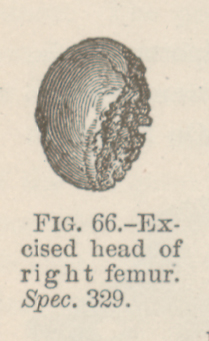Title: Machlin, F.
Source text: The Medical and Surgical History of the War of the Rebellion. (1861-65.), Part 3, Volume 2 (Washington, DC: Government Printing Office, 1883), 110.
Civil War Washington ID: med.d2e5930
TEI/XML: med.d2e5930.xml
CASE 258.—Private F. Machlin,¹ 11th Pennsylvania, a robust man, was wounded at the second battle of Bull Run, August 30, 1862. He laid on the field several days, and was then transported thirty miles in a wagon to the Warehouse Hospital, Georgetown, D. C., where he was received on September 8th. A musket ball had entered the right buttock and emerged an inch and a half below and within the anterior superior spinous process of the ilium. The limb was shortened, and the foot was everted; any movement gave excessive pain. A thorough examination was made under the influence of chloroform, and showed that the neck of the bone was comminuted and the shaft uninjured. The case was considered to be a particularly favorable one for the operation of excision of the broken fragments, and the general condition of the patient was such as to offer some hopes of its success, and it was determined to do the operation on the following day. But the surgeon in charge of the hospital was confined to his bed by illness, and was unable to see the patient for five days. On September 13th the general condition of the latter was less favorable. His pulse was 130, quick and weak, and his tongue was dry. He was placed under very careful nursing, and beef essence, brandy, eggs, and milk, and other concentrated nourishment and stimulants were administered ad libitum. By September 20th this treatment had produced slight improvement, and though he was still in a very unfavorable condition for an operation, it was determined, on consultation, that an excision might afford the patient relief from the constant pain he suffered, and that it could not greatly depress him. At noon on September 20th, accordingly Assistant Surgeon B. A. Clements, U. S. A., assisted by Dr. George K. Smith, of Brooklyn, and the surgical staff of the hospital, performed the operation. An incision five inches in length was made from a point two inches behind and an inch below the anterior superior process of the ilium, downward over the prominence of the trochanter major. The incision exposed the parts freely, and the muscular insertions being divided, and several small loose fragments of bone removed, the irregular broken extremity of the shaft, at its junction with the neck and the tip of the great trochanter, were excised by a chain saw. The remnant of the capsular ligament and the round ligament were now cut, the joint being opened from below and in front with a probe-pointed bistoury. A blade of a long bullet forceps was then introduced as a lever and the head was disarticulated by gently prying it out of the cotyloid cavity. These steps in the operation were facilitated by rotating the trochanter outward, and by lifting the extensor muscles by a metallic retractor. A small vessel was tied at the upper end and another at the lower end of the wound. The wound was well washed out by means of a syringe and a few stitches were applied, the middle portion of the wound being left open. The limb was suspended in a Smith's anterior wire splint. The patient appeared to rally from the operation satisfactorily. At 9 o'clock P. M. he was free from pain; his pulse was 136, and the skin was cool and natural. He had slept tranquilly. On the following day, September 21st, his pulse was 120 and very feeble. The discharge from the wound was dark and thin, and copious. His countenance was placid, the pinched, distressed expression it had worn having disappeared. But in the afternoon he sank rapidly, and died in the evening, thirty-six hours after the operation, September 21, 1862. The specimen is No. 329 of the Surgical Section of the Army Medical Museum, and is represented in the accompanying wood-cut (FIG. 66).—(Circular 6, S. G. O., 1865, p. 64; Circular 2, S. G. O., 1869, pp. 37, 135.)
¹ BATES (S. P.) (History of Pennsylvania Volunteers, 1861-5, Harrisburg, 1869, Vol. I, p. 30) records the name of this patient as Philip Mechling, Co. I, 11th Pennsylvania Volunteers.
